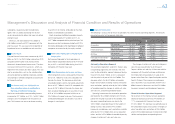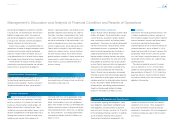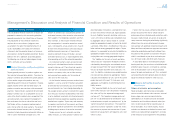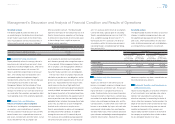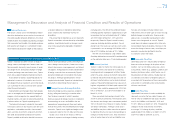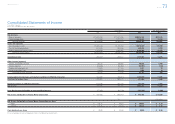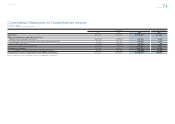Toyota 2013 Annual Report Download - page 68
Download and view the complete annual report
Please find page 68 of the 2013 Toyota annual report below. You can navigate through the pages in the report by either clicking on the pages listed below, or by using the keyword search tool below to find specific information within the annual report.
Toyota Global Vision President’s Message Launching a New Structure Special Feature Review of Operations
Consolidated Performance
Highlights
Management and
Corporate Information Investor InformationFinancial Section
Page 68
NextPrev
ContentsSearchPrint
ANNUAL REPORT 2013
The consolidated fi nancial statements of Toyota are
prepared in conformity with accounting principles
generally accepted in the United States of America.
The preparation of these fi nancial statements
requires the use of estimates, judgments and
assumptions that affect the reported amounts of
assets and liabilities at the date of the fi nancial
statements and the reported amounts of revenues
and expenses during the periods presented. Toyota
believes that of its signifi cant accounting policies,
the following may involve a higher degree of judg-
ments, estimates and assumptions:
Product Warranties and Recalls and Other
Safety Measures
Toyota generally warrants its products against cer-
tain manufacturing and other defects. Provisions for
product warranties are provided for specifi c periods
of time and/or usage of the product and vary
depending upon the nature of the product, the geo-
graphic location of the sale and other factors. All
product warranties are consistent with commercial
practices. Toyota includes a provision for estimated
product warranty costs as a component of cost of
sales at the time the related sale is recognized. The
accrued warranty costs represent management’s
best estimate at the time of sale of the total costs
that Toyota will incur to repair or replace product
parts that fail while still under warranty. The amount
of accrued estimated warranty costs is primarily
based on historical experience of product failures as
well as current information on repair costs. The
amount of warranty costs accrued also contains an
estimate of warranty claim recoveries to be received
from suppliers. The foregoing evaluations are inher-
ently uncertain, as they require material estimates
and some products’ warranties extend for several
years. Consequently, actual warranty costs may dif-
fer from the estimated amounts and could require
additional warranty provisions. If these factors
require a signifi cant increase in Toyota’s accrued
estimated warranty costs, it would negatively affect
future operating results of the automotive operations.
An estimate of warranty claim accrued for each
fi scal year is calculated based on the estimate of
warranty claim per unit. The estimate of warranty
claim per unit is calculated by dividing the actual
amounts of warranty claim, net of claim recovery
cost received from suppliers, by the number of
sales units for the fi scal year.
As the historical recovery amounts received from
suppliers is used as a factor in Toyota’s calculation
of estimated accrued warranty cost, the estimated
accrued warranty cost may change depending on
the average recovery amounts received from suppli-
ers in the past. However, Toyota believes that there
is not a signifi cant uncertainty of estimated amounts
based on historical experience regarding recoveries
received from suppliers. Toyota may seek recovery
to suppliers over the life of the warranty, and there
are no other signifi cant special terms and conditions
including cap on amounts that can be recovered.
Toyota accrues for costs of recalls and other
safety measures, as well as product warranty cost
Critical Accounting Estimates
Management’s Discussion and Analysis of Financial Condition and Results of Operations
described above, included as a component of cost
of sales at the time of vehicle sale. Toyota provides
for such “liabilities for recalls and other safety mea-
sures” at the time of vehicle sales comprehensively
by aggregate sales of various models in a certain
period by geographical regions instead of by individ-
ual models. While there is no difference in the calcu-
lation method among geographical regions, Toyota
believes it is reasonable to calculate the liabilities by
geographical regions because of factors such as
varying labor costs among geographical regions.
The “liabilities for the costs of recalls and other
safety measures” recorded in the balance sheet is
calculated by deducting the “accumulated amount
of repair cost paid” from the “expected liability for
the cost of recalls and other safety measures”. As
such, this liability is evaluated every period based on
new data and are adjusted as appropriate. Toyota
calculates these liabilities for units sold in the current
period and each of the past 10 fi scal years, and
aggregates such liabilities in determining the fi nal
liability amount.
The “expected liability for the cost of recalls and
other safety measures” are calculated by multiplying
the “sales unit” by the “expected average repair
cost per unit”. The “expected average repair cost
per unit” is calculated based on dividing the “accu-
mulated amount of repair cost paid per unit” by the
“pattern of payment occurrences”. The “pattern of
payment occurrence” represents a ratio that shows
the measure of payment occurrence over 10 years
based on actual payments with regard to units sold
within 10 years.
Factors that may cause a difference between the
amount accrued at the time of vehicle sale and
actual payment on individual recalls and other safety
measures mainly include actual cost of recalls and
safety measures during the period being signifi cantly
different from the accumulated amount of repair
cost paid per unit (generally comprised of parts and
labor) and the actual pattern of payment occurrence
during the period being signifi cantly different from
the pattern of the payment occurrence in the past,
which is considered as part of our estimation pro-
cess for future recalls and other safety measures.
As described above, in estimating the compre-
hensive provision, the actual cost of individual recalls
and other safety measures is included as a compo-
nent of the calculation such as the accumulated
amount of repair cost paid per unit. Thus, an individ-
ual recall announcement generally does not directly
impact the fi nancial statements when it occurs.
Allowance for Doubtful Accounts and
Credit Losses
Natures of estimates and assumptions
Retail receivables and fi nance lease receivables
consist of retail installment sales contracts secured
by passenger cars and commercial vehicles.
Collectability risks include consumer and dealer
insolvencies and insuffi cient collateral values (less
costs to sell) to realize the full carrying values of
these receivables. As a matter of policy, Toyota
maintains an allowance for doubtful accounts and
credit losses representing management’s estimate
of the amount of asset impairment in the portfolios
Selected Financial Summary (U.S. GAAP) Consolidated Segment Information Consolidated Quarterly Financial Summary Management’s Discussion and Analysis of Financial Condition and Results of Operations [23 of 26] Consolidated Financial Statements Notes to Consolidated Financial Statements
Management’s Annual Report on Internal Control over Financial Reporting Report of Independent Registered Public Accounting Firm






